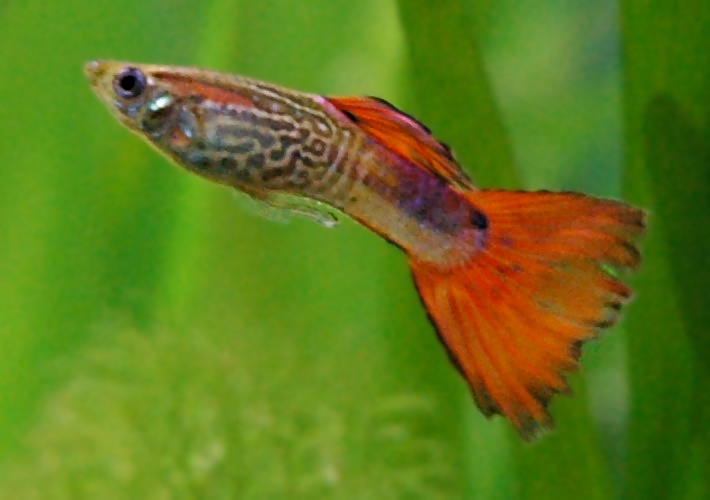Guppy (Poecilia reticulata) - Wiki Guppy
From Wikipedia, the free encyclopedia
[Photo] Guppy male. Photographer:User:Jdiemer http://commons.wikimedia.org/wiki/User:Jdiemer Date: Jan 22 2005 Location: Braunschweig, Germany
The guppy (Poecilia reticulata), also commonly known as guppie is one of the most popular freshwater aquarium fish species in the world. It is a small member of the Poecilidae family (females 4 centimetres long, males 2½???3 centimetres long) and like all other members of the family, is live-bearing. It prefers a hard water aquarium and can withstand levels of salinity up to 150% sea water (58 ppt sodium chloride)[1], which has led to them being occasionally included in marine tropical community tanks, as well as in freshwater tropical tanks. Its most famous characteristic is its propensity for breeding, and can breed in both fresh water and marine aquariums.
Taxonomy
Robert John Lechmere Guppy (1836-1916) discovered this tiny fish in Trinidad in 1866, although the fish was known to German aquarists prior to that time.
Ecology and behaviour
There is a great deal of variety between the populations, many with distinctive coloring or patterning. Those that live in habitats where predators are common tend to be less vividly decorated. Populations that deal with fewer predators are much more colorful. Recent studies suggest that vividly colored males are favored via sexual selection (Handicap principle) while natural selection via predation favors subdued tones. As a result, the dominant phenotypes observed within a reproductively isolated community are a function of the relative importance each factor has in a particular environment.
Occasionally male guppies may behave aggressively towards each other, engaging in fin-nipping and other bullying behaviour. This behaviour is also sometimes exhibited towards other top swimmers like platys and swordtails and occasionally other fish with prominent fins such as angelfish.
Guppies live in complex networks, choosing social partners and remembering them. [3].
The extensive work on guppies is summarised in Anne Magurran's Evolutionary Ecology: the Trinidadian guppy.
Reproduction
Guppy breeding by aquarists produces variations in appearance ranging from color consistency to fantails and "spike" swordtails. Selective breeding has created an avid "fancy guppy" collector group, while the "wild" guppy maintains its popularity as one of the hardiest aquarium fish. The gestation period of a guppy is 22-26 days. When the female guppy becomes fertilized, a dark area near the anus, known as the gravid spot, will enlarge and darken. Guppies prefer water temperatures of about 22 °C (72 °F) for reproduction. After giving birth, the female is ready for conception within a few hours. If a male does not mate with the female soon after birth, the female can use stored sperm from the previous mating.
People breeding their own guppies should be aware that the adults will eat their young. Specially designed livebearer birthing tanks, which can be suspended inside the aquarium, are available from aquatic retailers. These serve the dual purpose of shielding the pregnant female from further attention from the males, and of providing a separate area for the newborn young as protection from being eaten by their mother.
Another option for aquarists is to simply provide lots of plants for the young to hide in. Immediately after giving birth, female guppies experience a rush of hormones which serve to decrease their appetites. This can last up to 12 hours, which provides the fry ample time to hide provided that no other adult fishes are around.
Guppies do not survive well in a closed environment.
http://en.wikipedia.org/wiki/Guppy
| The text in this page is based on the copyrighted Wikipedia article shown in above URL. It is used under the GNU Free Documentation License. You may redistribute it, verbatim or modified, providing that you comply with the terms of the GFDL. |
